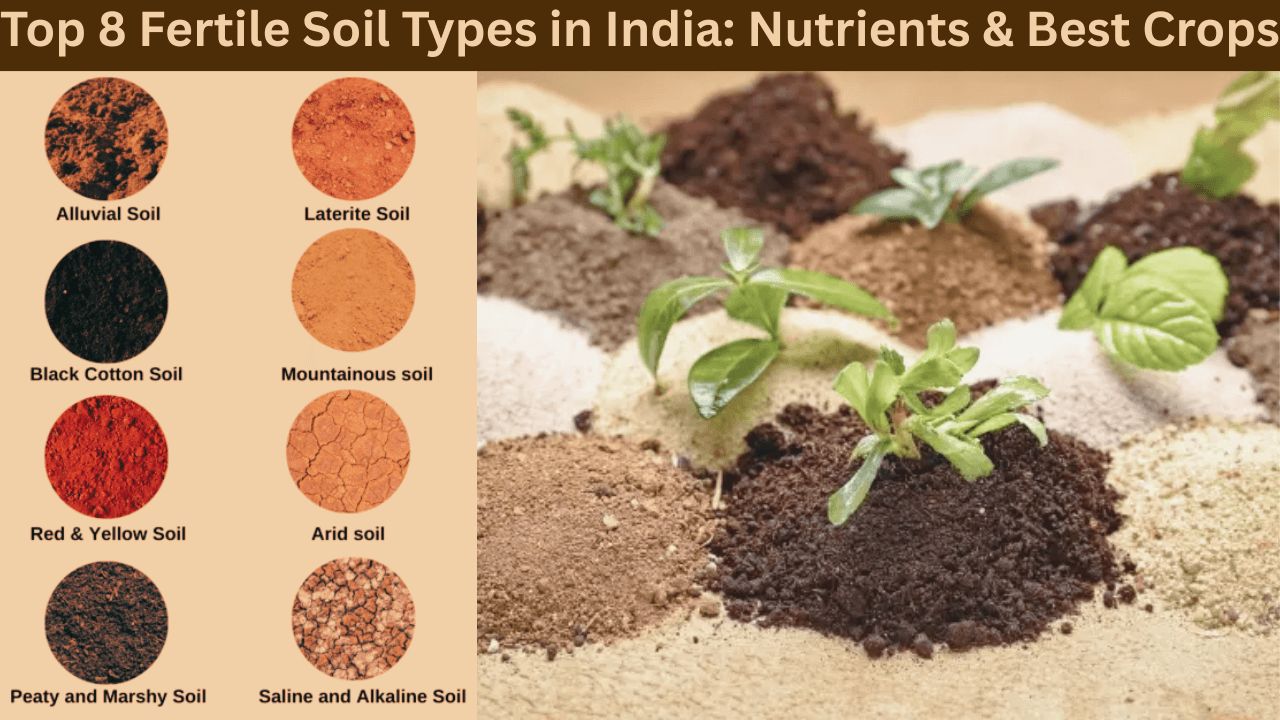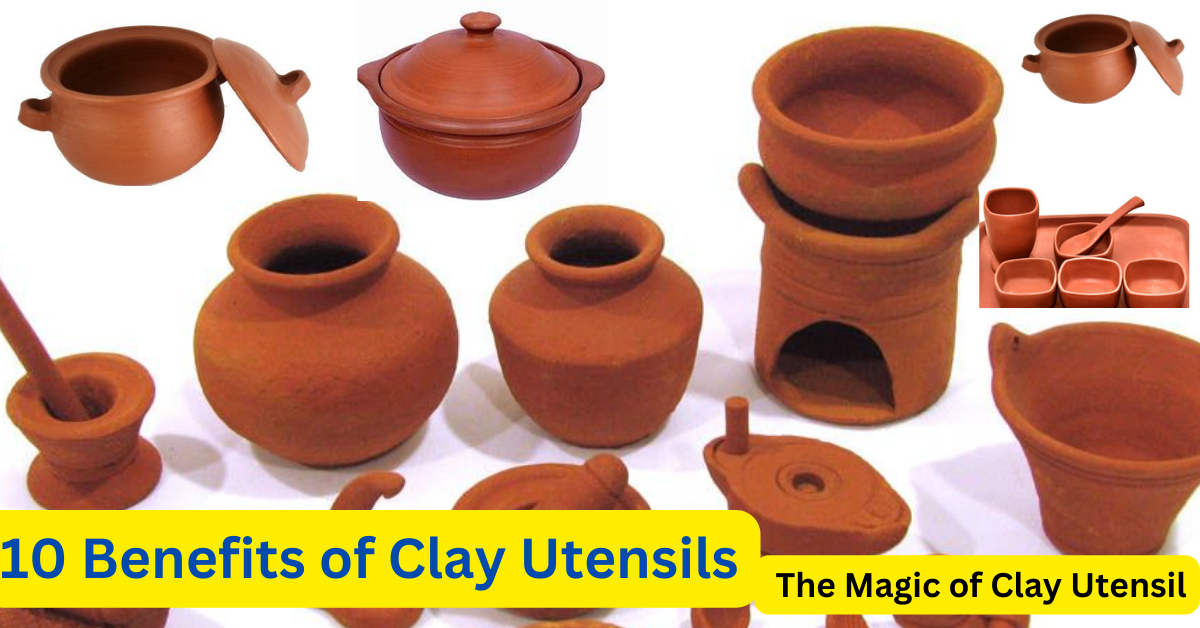
Table of Contents
Soil Types in India with Nutrient Composition & Crop Suitability
Soil Types in India : 🌾 Types of Soil in India: Nutrient Profiles, Regional Distribution & Best CropsIndia’s agricultural landscape is shaped by its diverse soil types, each offering unique properties that influence crop yield, water retention, and nutrient availability. Whether you’re a farmer, student, or agri-entrepreneur, understanding these soils is key to sustainable farming and smart land use.Here’s a detailed guide to the 8 major soil types found in India, their nutrient composition, regional presence, and ideal crops.
Major Soil Types in India: Nutrients & Best Crops
🧱 1. Clay Soil (चिकनी मिट्टी)
Overview:
- Dense and compact with high water retention
- Poor drainage, prone to waterlogging
Regions Found: Northern plains, parts of Bihar and Uttar Pradesh
Nutrient Profile: - Nitrogen: 0.1–0.3%
- Phosphorus: 0.05–0.2%
- Potash: 0.4–0.6%
- Organic Matter: 1–2%
- Lime: 2–6%
Best Crops: - Rice (especially in paddy fields)
- Wheat
- Sugarcane
Farming Tip: Use raised beds and organic compost to improve aeration and root development.
🌕 2. Yellow Soil (पीली मिट्टी)
Overview:
- Light texture, moderate fertility
- Often acidic in nature
Regions Found: Eastern India, parts of Odisha and Assam
Nutrient Profile: - N: 0.05–0.1%
- P: 0.01–0.05%
- K: 0.3–0.5%
- Organic Matter: 0.5–1%
- Lime: 1–2%
Best Crops: - Pulses (lentils, gram)
- Oilseeds (mustard, sunflower)
Farming Tip: Apply lime to neutralize acidity and boost phosphorus uptake.
🌑 3. Black Soil (काली मिट्टी)
Overview:
- Rich in iron and magnesium
- Excellent moisture retention
Regions Found: Maharashtra, Madhya Pradesh, Gujarat, parts of Andhra Pradesh
Nutrient Profile: - N: 0.1–0.2%
- P: 0.1–0.2%
- K: 0.5–0.6%
- Organic Matter: 1–2%
- Lime: 5–10%
Best Crops: - Cotton (most suitable)
- Soybean
- Sorghum (jowar)
Farming Tip: Deep plowing helps break compact layers and improve root penetration.
🏞️ 4. Alluvial Soil (जलोढ़ मिट्टी)
Overview:
- Formed by river deposits
- Highly fertile and versatile
Regions Found: Indo-Gangetic plains, Punjab, Haryana, West Bengal
Nutrient Profile: - N: 0.05–0.15%
- P: 0.05–0.1%
- K: 0.4–0.5%
- Organic Matter: 1–1.5%
- Lime: 1–2%
Best Crops: - Rice
- Wheat
- Sugarcane
- Vegetables
Farming Tip: Rotate crops to maintain soil fertility and reduce pest buildup.
🏖️ 5. Sandy Soil (बलुई मिट्टी)
Overview:
- Loose texture, low water retention
- Quick drainage, low fertility
Regions Found: Rajasthan, parts of Haryana and Tamil Nadu
Nutrient Profile: - N: 0.02–0.05%
- P: 0.01–0.05%
- K: 0.1–0.3%
- Organic Matter: 0.5–1%
- Lime: 0.5–1%
Best Crops: - Groundnut
- Carrot
- Potato
- Melons
Farming Tip: Use drip irrigation and mulching to conserve moisture.
🔥 6. Laterite Soil (ऊष्ण मिट्टी)
Overview:
- Rich in iron and aluminum
- Low fertility, porous texture
Regions Found: Western Ghats, Kerala, Karnataka, Tamil Nadu
Nutrient Profile: - N: 0.05–0.1%
- P: 0.01–0.05%
- K: 0.3–0.5%
- Organic Matter: 0.5–1%
- Lime: 1–2%
Best Crops: - Tea
- Coffee
- Cashew
- Rubber
Farming Tip: Regular organic amendments improve fertility and structure.
🌾 7. Crop Soil (फसल मिट्टी)
Overview:
- Cultivated and enriched for agriculture
- Balanced nutrient profile
Regions Found: Across India in managed farmlands
Nutrient Profile: - N: 0.1–0.2%
- P: 0.05–0.1%
- K: 0.4–0.5%
- Organic Matter: 1–2%
- Lime: 1–2%
Best Crops: - Seasonal vegetables
- Cereals
- Legumes
Farming Tip: Regular soil testing helps maintain optimal nutrient levels.
🟥 8. Red Soil (लाल मिट्टी)
Overview:
- High iron content, low nitrogen
- Slightly acidic, moderate fertility
Regions Found: Tamil Nadu, Karnataka, Chhattisgarh, Jharkhand
Nutrient Profile: - N: 0.05–0.1%
- P: 0.01–0.05%
- K: 0.3–0.5%
- Organic Matter: 0.5–1%
- Lime: 1–2%
Best Crops: - Millets
- Groundnut
- Pulses
Farming Tip: Add compost and green manure to boost nitrogen levels.
🌿 Conclusion: Why Soil Knowledge Matters
Understanding soil types is the foundation of smart agriculture. From nutrient management to crop selection, soil science empowers farmers to make informed decisions that enhance productivity and preserve ecological balance.
Whether you’re cultivating cotton in black soil or growing tea in laterite regions, tailoring your approach to the soil’s natural strengths is the key to long-term success.
SoilTypes #IndianAgriculture #FarmingIndia #SoilHealth #CropPlanning #BlackSoil #AlluvialSoil #ClaySoil #RedSoil #SandySoil #LateriteSoil #OrganicFarming #SoilScience #AgriIndia #SustainableFarming #FarmersOfIndia #SoilNutrients #AgricultureTips #SoilMatters #KnowYourSoil


